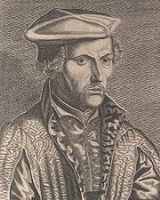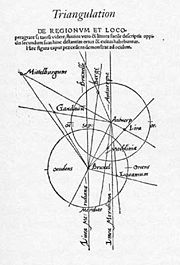
Gemma Frisius
Encyclopedia

Mathematics
Mathematics is the study of quantity, space, structure, and change. Mathematicians seek out patterns and formulate new conjectures. Mathematicians resolve the truth or falsity of conjectures by mathematical proofs, which are arguments sufficient to convince other mathematicians of their validity...
, cartographer
Cartography
Cartography is the study and practice of making maps. Combining science, aesthetics, and technique, cartography builds on the premise that reality can be modeled in ways that communicate spatial information effectively.The fundamental problems of traditional cartography are to:*Set the map's...
, philosopher, and instrument maker. He created important globe
Globe
A globe is a three-dimensional scale model of Earth or other spheroid celestial body such as a planet, star, or moon...
s, improved the mathematical instruments of his day and applied mathematics in new ways to surveying and navigation.
He was born in Dokkum
Dokkum
Dokkum is a Dutch fortified town in the municipality of Dongeradeel in the province of Friesland. It has 13,145 inhabitants . The fortifications of Dokkum are well preserved and are known as the bolwerken . - History :...
, Friesland
Friesland
Friesland is a province in the north of the Netherlands and part of the ancient region of Frisia.Until the end of 1996, the province bore Friesland as its official name. In 1997 this Dutch name lost its official status to the Frisian Fryslân...
(present-day Netherlands
Netherlands
The Netherlands is a constituent country of the Kingdom of the Netherlands, located mainly in North-West Europe and with several islands in the Caribbean. Mainland Netherlands borders the North Sea to the north and west, Belgium to the south, and Germany to the east, and shares maritime borders...
) of poor parents, who died when he was young. He moved to Groningen and studied at the University in Leuven
Katholieke Universiteit Leuven
The Katholieke Universiteit Leuven is a Dutch-speaking university in Flanders, Belgium.It is located at the centre of the historic town of Leuven, and is a prominent part of the city, home to the university since 1425...
beginning in 1525. He received the degree of MD in 1536 and remained on the faculty of medicine in Leuven for the rest of his life. His oldest son, Cornelius Gemma
Cornelius Gemma
Cornelius Gemma was a physician, astronomer and astrologer, and the oldest son of cartographer and instrument-maker Gemma Frisius...
, edited a posthumous volume of his work and continued to work with Ptolemaic astrological models.
While still a student, Frisius set up a workshop to produce globes and mathematical instruments. He became noted for the quality and accuracy of his instruments, which were praised by Tycho Brahe
Tycho Brahe
Tycho Brahe , born Tyge Ottesen Brahe, was a Danish nobleman known for his accurate and comprehensive astronomical and planetary observations...
, among others. In 1533, he described for the first time the method of triangulation
Triangulation
In trigonometry and geometry, triangulation is the process of determining the location of a point by measuring angles to it from known points at either end of a fixed baseline, rather than measuring distances to the point directly...
still used today in surveying. Twenty years later, he was the first to describe how an accurate clock could be used to determine longitude
Longitude
Longitude is a geographic coordinate that specifies the east-west position of a point on the Earth's surface. It is an angular measurement, usually expressed in degrees, minutes and seconds, and denoted by the Greek letter lambda ....
. Jean-Baptiste Morin (1583–1656) did not believe that Frisius' method for calculating longitude would work, remarking, "I do not know if the Devil will succeed in making a longitude timekeeper but it is folly for man to try."
Frisius created or improved many instruments, including the cross-staff, the astrolabe
Astrolabe
An astrolabe is an elaborate inclinometer, historically used by astronomers, navigators, and astrologers. Its many uses include locating and predicting the positions of the Sun, Moon, planets, and stars, determining local time given local latitude and longitude, surveying, triangulation, and to...
and the astronomical rings
Astronomical rings
Astronomical rings , also known as Gemma's rings, are an early astronomical instrument. The instrument consists of three rings, the meridien, the equator, and the declination ring...
. His students included Gerardus Mercator
Gerardus Mercator
thumb|right|200px|Gerardus MercatorGerardus Mercator was a cartographer, born in Rupelmonde in the Hapsburg County of Flanders, part of the Holy Roman Empire. He is remembered for the Mercator projection world map, which is named after him...
(who became his collaborator), Johannes Stadius
Johannes Stadius
Johannes Stadius or Estadius was a Flemish astronomer, astrologer, and mathematician.-Life:...
, John Dee
John Dee (mathematician)
John Dee was an English mathematician, astronomer, astrologer, occultist, navigator, imperialist and consultant to Queen Elizabeth I. He devoted much of his life to the study of alchemy, divination and Hermetic philosophy....
, Andreas Vesalius and Rembert Dodoens
Rembert Dodoens
Rembert Dodoens was a Flemish physician and botanist, also known under his Latinized name Rembertus Dodonaeus.-Biography:...
.
A lunar crater
Gemma Frisius (crater)
Gemma Frisius is a lunar crater that is located in the rugged southern highlands of the Moon. It lies to the north of the walled plain Maurolycus, and southeast of the smaller crater Poisson. The crater Goodacre is attached to the northeast rim....
has been named after him.
Works

- (Cosmographia (1529) von Petrus ApianusPetrus ApianusPetrus Apianus , also known as Peter Apian, was a German humanist, known for his works in mathematics, astronomy and cartography.The lunar crater Apianus and minor planet 19139 Apian are named in his honour....
, annotated by Gemma Frisius) - De principiis astronomiae et cosmographiae (1530)
- De usu globi (1530)
- Libellus de locorum describendorum ratione (1533)
- Arithmeticae practicae methodus facilis (1540)
- De annuli astronomici usu (1540)
- De radio astronomico et geometrico (1545)
- De astrolabio catholico (1556)
Further reading
- N. Haasbroek: Gemma Frisius, Tycho Brahe and Snellius and their triangulations. Delft 1968.
- Robert Haardt: The globe of Gemma Frisius. Imago mundi, Bd. 9, 1952.
- W. Karrow: Mapmakers of the Sixteenth Century and Their Maps. Chicago 1993.
- G. Kish: Medicina, mensura, mathematica: The Life and Works of Gemma Frisius. Minneapolis 1967, sowie sein Artikel in Dictionary of Scientific Biography
- A. Pogo: Gemma Frisius, his method of determining longitude. In: Isis. Bd. 22, 1935, S.469-485.
External links
- http://www.acmi.net.au/AIC/CAM_OBS_LOUVAIN_1544.GIFDescription of the Camera ObscuraCamera obscuraThe camera obscura is an optical device that projects an image of its surroundings on a screen. It is used in drawing and for entertainment, and was one of the inventions that led to photography. The device consists of a box or room with a hole in one side...
in 1544 by Frisius]

